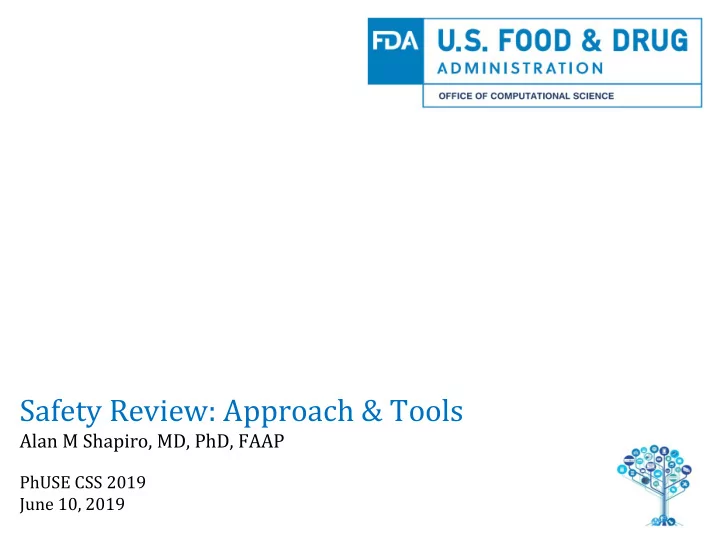

Safety Review: Approach & Tools Alan M Shapiro, MD, PhD, FAAP PhUSE CSS 2019 June 10, 2019
Disclaimer Statement Disclaimer The views and opinions presented here represent those of the speakers and should not be considered to represent advice or guidance on behalf of the U.S. Food and Drug Administration. 2
Presentation Overview 01 Safety Review Approach Review Tools 02 3
SAFETY REVIEW APPROACH Former Primary Reviewer’s View 4
Example: NDA Review of Updating Proposed Prescribing Information (PI) Sponsor’s Proposed PI: Warnings & Precautions: • Suicidality (class labeling) • Dizziness/Somnolence • Withdrawal of AEDs Final PI: ( anti-epileptic drug) Boxed Warning: • Serious Psychiatric and Behavioral Reactions Safety Issues Identified Review Tools Warnings & Precautions: from IND Stage • Suicidality (class labeling) • Dizziness/Somnolence • Falls Chemical or Biological • Withdrawal of AEDs Epitopes of Concern Product Class Issues 5
Clinical Review Template NDA/BLA Multi-disciplinary Review and Evaluation Section 8.2: Review of Safety 8.2.1 Safety Review Approach 8.2.2 Review of the Safety Database 8.2.3 Adequacy of Applicant’s Clinical Safety Assessments 8.2.4 Safety Results 8.2.5 Analysis of Submission-Specific Safety Issues 8.2.6 Clinical Outcome Assessment (COA) Analyses Informing Safety/Tolerability 8.2.7 Safety Analyses by Demographic Subgroups 8.2.8 Specific Safety Studies/Clinical Trials 8.2.9 Additional Safety Explorations 8.2.10 Safety in the Postmarket Setting 8.2.11 Integrated Assessment of Safety 6
Assessment of Submitted Data Assess the adequacy of overall exposure and submission-specific aspects of the safety database Is safety population sufficiently diverse to represent the expected target population? Assess whether pooled analyses facilitate the detection of drug-related adverse events Assess the breadth of the safety data Does it facilitate the generalizability of safety findings? 7
Adequacy of Safety Assessment Were applicant’s safety evaluations during a product’s development program adequate? – Were all reasonably applicable clinical safety evaluations conducted? – Were these evaluations performed at the appropriate time(s) during the trial(s)? 8
Data Integrity of Safety Data Assess consistency of the data provided comparing information from a variety of sources: – case report forms (CRFs), case report tabulations and narrative summaries – submitted datasets Did certain sites, countries, or regions report minimal or zero adverse events? Are the adverse events reported similarly across all sites, countries, or regions? Are the adverse events common at certain sites, countries, or regions? 9
Issues Regarding Overall Submission Quality Is applicant’s approach to safety reasonable and appropriate? – Is process for recording, coding, and categorizing adverse events (AEs) acceptable? – Has applicant provided accurate definitions of AEs and serious adverse events (SAEs) in the protocol(s)? – Has the applicant defined “treatment emergent” adverse events (TEAEs) and is the definition appropriate? – Is the methodology and frequency of routine clinical testing adequate? 10
Safety Tasks of a Reviewer 1 To evaluate the adequacy of the data available to support the safety analysis and to identify the limitations of those data • Assessments of whether the extent of exposure at relevant doses is adequate 2 To identify and closely examine serious adverse events that could signal important problems with a drug • Assess whether adverse reactions are severe enough to prevent its use altogether, to limit its use, or require special risk management efforts? 3 To identify and estimate the frequency of the common (usually nonserious) adverse events • Directly related or possibly causally related to the use of the drug 4 To identify unresolved safety concerns, such as the absence of data from high-risk populations or potential interactions that will need attention • Before approval, or should it be assessed in the post marketing period 11 11
Additional Safety Review Tasks Identify factors that predict the occurrence of adverse reactions, including subject-related and drug-related factors Identify, where possible, ways to avoid adverse reactions (e.g., dosing, monitoring) and ways to manage them when they occur For a drug that is to be approved, provide a comprehensive evaluation of risk information adequate to support a factual and sufficient summary in labeling 12
REVIEW TOOLS 13
NDA/BLA Multi-disciplinary Review and Evaluation Safety Subsection 8.24 Safety Results • Deaths • Serious Adverse Events • Dropouts and/or Discontinuations due to Adverse Events • Significant Adverse Events • Treatment Emergent Adverse Events and Adverse Reactions • Laboratory Findings • Vital Signs • Electrocardiograms (ECGs) • QT 14
Tools NDA/BLA Safety Review • MAED (MedDRA-based Adverse Events Diagnostics) • Commercially available tools that facilitate dataset analyses • Other review tools: – SAS and R – R Shiny Tools: • AE Temporal, Demographic, Hepatotoxicity, and Napoleon’s March – CDER Clinical Investigator Site Selection Tool (CISST) – FDALabel 15
Safety Results: Use of Tools for Deaths, SAEs, DCs, TEAEs • Perform exploratory adverse event analyses – Incidence tables of AEs in MedDRA hierarchy (MAED or commercially available tools) – Forest Plots (commercially available tools) – Structured MedDRA Query (SMQ) analyses (MAED or commercially available tools ) – Custom MedDRA Query (CMQ) analyses (MAED) – Laboratory and Vitals Analyses (commercially available tools) – Hy’s Law Analyses (commercially available tools) • Review individual patients – Graphical Patient Profiles (commercially available tools) – Narratives – Case Report Forms (CRFs) 16
MAED Functions and Outputs • MAED Functions: – Runs all levels of the MedDRA hierarchy – Runs all SMQs – Performs custom queries (add PTs from excel file) – Matches the AE terms to MedDRA terms • MAED Outputs: – Excel file for all requested analyses – 2 Augmented datasets (sas7bdat, xpt) with new variables added to the original AE dataset • MAED AE Dataset with new MedDRA hierarchy variables • MAED SMQ Dataset with new SMQ variables 17
MAED SMQ Analyses 18
Incidence Table by SOC 19
Forest Plots 20
Graphical Patient Profile 21
Plots to Identify Potential Hy’s Law Cases 22
Graphical Patient Profile 23
Analysis Toolbox – R Shiny Tools 24
Recommend
More recommend